Perhaps it will someday be enshrined in a museum, but today, the XFL’s only championship trophy resides in the living room of J.K. McKay’s home in the Pacific Palisades district of Los Angeles.
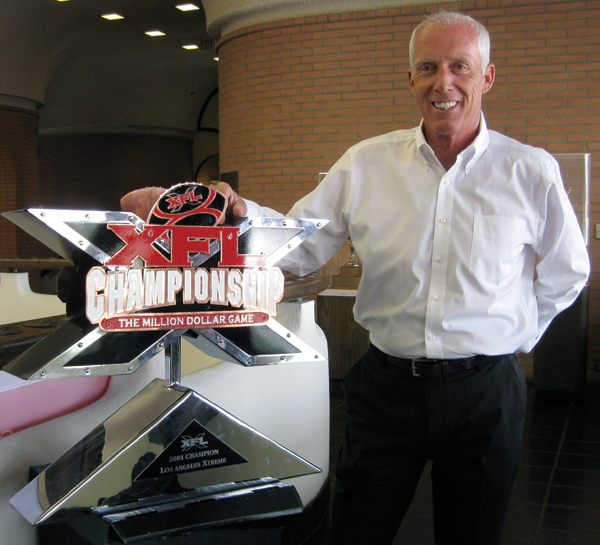 |
USCTROJANS.COM
"The first thing people always ask is, 'What is that thing?'" says J.K. McKay of the XFL trophy.
|
The award sits near McKay’s Rose Bowl MVP trophy, an array of championship rings, and various awards won by his father during John McKay’s hall of fame career.
The symbol of XFL supremacy doesn’t resemble any of the other football trophies. Like the league itself, it’s considerably more distinct. In fact — and perhaps befitting something conceived by WWE Chairman Vince McMahon — the XFL championship trophy’s garishness is what elicits the most comments.
“The first thing people always ask is, ‘What is that thing?’ It looks like beer might come out it,” said McKay, who was general manager of the championship-winning Los Angeles Xtreme franchise. Today, he’s senior associate athletic director at USC to Pat Haden, with whom he shared the 1975 Rose Bowl MVP honors.
Ten years ago this month, the league co-owned by NBC and McMahon folded unexpectedly after a lone season of play. It was a year that began with a mighty 9.5 prime-time rating on the league’s opening night. By the time of the final regular-season game, that number on NBC had dropped to an anemic 1.5, which at the time was the lowest mark ever posted by a major network for a prime-time, first-run sports telecast on a weekend.
During its only year of existence, the XFL became a favorite media whipping boy. In 2004, ESPN.com named the XFL the second-biggest sports flop of the previous 25 years, ranking behind short-lived NFL quarterback Ryan Leaf. Last year, TV Guide Network ranked the XFL as one of the 25 biggest TV blunders.
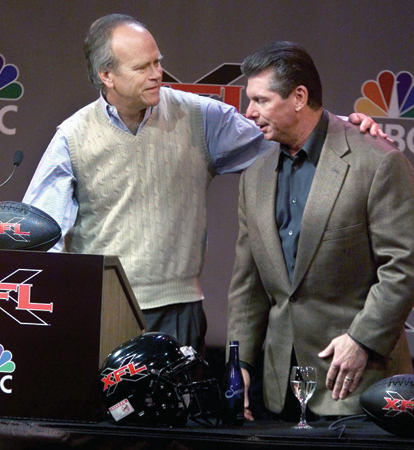 |
AP IMAGES
NBC’s Dick Ebersol (left) and WWE’s Vince McMahon unveiled the XFL in March 2000 and shuttered it in 2001. |
But a decade after its one and only season offers an appropriate window to assess what the XFL’s legacy really is.
At the highest levels, memories of the XFL are painful enough that neither the PR apparatus of NBC nor WWE wanted their executives to speak about it. But that doesn’t mean the people who built the league now wear the letters “XFL” as a latter-day scarlet A.
“I’d do it again in a New York minute,” said Rich Rose, a consultant who wrote the league’s original single-entity business plan over 19 days in the Stamford, Conn., offices of what was then known as WWF, along with former XFL President Basil DeVito. “Building it from the ground up was one of the most enjoyable things I ever did professionally.”
Recalled Jared Bartie, former XFL vice president of legal affairs who helped both start and close down the league, “Play could have been more compelling, and people will forever question scheduling it in a Saturday night time block.” But Bartie, who currently heads the sports practice at Arent Fox in New York City, added, “It was still something in my career where I probably had the most fun, because we all had a blank canvas.”
Paul Kayaian, former XFL director of sponsorship sales, helped sell $41 million worth of corporate sponsorships and advertising for the league. Kayaian also has sold for NASCAR, the NBA and the NFL, but he credited the XFL for giving him an unfettered ability to be creative. “You never had anyone pulling at your elbow and saying, ‘You can’t do that,’” said Kayaian, who now runs his own consulting company, Mosaic Enterprises. “We’d do almost anything.’’
One of the XFL’s tag lines was “Real Football,” but league and team executives quickly realized that almost everything was on the table.
That was in evidence during an early-season meeting in Los Angeles with, among others, McMahon, NBC Sports President Ken Schanzer and Gerry DiNardo, who coached the league’s Birmingham Thunderbolts franchise. During the meeting, DiNardo recalled, someone proposed that the XFL change the rules to make every player an eligible receiver.
McMahon was willing to make that change immediately for the following week’s games, but Memphis coach Kippy Brown and Orlando coach Galen Hall, who were also in the meeting, reminded McMahon of his promise that the XFL would always be football.
“Vince looked them in the eye and said, ‘You are right. I gave you my word.’ Then, there was no way everyone was going to be eligible,” said DiNardo, now an analyst with the Big Ten Network.
The desire to make quick changes sometimes did go too far, though, and critics complained that the league changed rules too frequently during the season. For example, the XFL started with rules that allowed bump-and-run coverage anywhere on the field. Five weeks into the season, those rules were changed to allow only the more conventional pass defense.
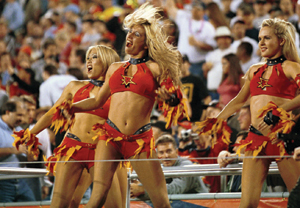 |
GETTY IMAGES
The XFL's focus on off-the-field happenings tested what was acceptable to broadcasters and football fans. |
Off the field, balancing McMahon’s Barnum-esque talent for promotion with standards of programming that were acceptable to broadcasters and football fans was a difficult task.
During the season’s first telecast, NBC came back from a commercial break with a framed shot of one of the Las Vegas cheerleaders, from her neck to her navel.
Matt Vasgersian, who was doing play-by-play at the time, was shocked. “It was basically everything that in the TV industry they tell directors not to shoot between innings for fear of offending a stage manager or somebody who’s watching on a satellite,” said Vasgersian, now with MLB Network.
But this was the XFL. As soon as the shot came up on screen, the left side of Vasgersian’s earphones opened. It was McMahon, saying, “That’s just the kind of thing we talked about, Matt. That’s America, Matt. That’s the XFL.”
“Vince is not even through when my right ear opens,” Vasgersian says, “and it’s Dick [Ebersol, NBC Sports chairman], who’s in a different production trailer. And he says, ‘Matt, be careful. Remember what we talked about. Be careful.’
“What ends up coming out of my mouth is the following statement: ‘Well, this is uncomfortable.’ It was a disaster from that moment on. I knew I was done.”
The WWF marketing influence also could be found in the league’s TV promos, which ranged from one that showed near-naked cheerleaders in the showers to another that depicted XFL players preparing for the coming season with tanks, trucks and wrecking balls as training aids.
This was to be a league that played only outdoors, without fair catches, extra points, artificial grass or any of the other modern amenities that McMahon viewed as wimpy affectations. But the advertised brand of smash-mouth football never materialized, and the fact that the best ratings the league ever got came in the first half of its first game — indeed, the best ratings of any nationally televised program that was airing on the league’s debut Saturday night — showed the power of the WWF promotional machine.
As any MBA will tell you, generating consumer trial is no guarantee of repeat purchase.
“Those initial ratings tell you they had superior promotion,” said Stephen Greyser, a Harvard Business School professor who co-authored a Harvard Business Review study on the XFL and still highlights the XFL as a case study in his Business of Sports course. “They just did not put as much emphasis on building the product as they did on building the hype.”
XFL RATINGS:
A CONSISTENT DOWNWARD SPIRAL
Ratings for XFL games across the league's TV partners slipped after Week 1 and continued a general decline through the season. Following are weekly ratings for the league and their week-to-week changes.
WEEKLY NUMBERS
| |
NBC |
CHANGE |
TNN |
CHANGE |
UPN |
CHANGE |
| Week 1 |
9.5 |
— |
— |
— |
3 |
— |
| Week 2 |
4.6 |
-52% |
2.4 |
— |
2.1 |
-30% |
| Week 3 |
3.1 |
-33% |
1.2 |
-50% |
1.5 |
-29% |
| Week 4 |
2.6 |
-16% |
1.1 |
-8% |
1.4 |
-7% |
| Week 5 |
2.4 |
-8% |
0.9 |
-18% |
1.2 |
-14% |
| Week 6 |
2.4 |
0% |
0.8 |
-11% |
1.1 |
-8% |
| Week 7 |
1.6 |
-33% |
0.6 |
-25% |
1 |
-9% |
| Week 8 |
1.8 |
13% |
0.6 |
0% |
0.7 |
-30% |
| Week 9 |
1.5 |
-17% |
0.5 |
-17% |
0.7 |
0% |
| Week 10 |
1.5 |
0% |
0.3 |
-40% |
0.6 |
-14% |
| Week 11* |
1.8 |
20% |
— |
— |
0.7 |
17% |
| Week 12* |
2.1 |
17% |
— |
— |
— |
— |
| AVG. |
3 |
|
0.9 |
|
1.3 |
|
* Playoff games
Source: SportsBusiness Daily archives
McMahon’s in-your-face promotional efforts had the league opening like a theatrical premiere, generating that handsome 9.5 rating. The rating on NBC dropped 52 percent in the second week, another 33 percent in the third week and another 16 percent in the fourth week, down to a 2.6 (see chart). For the season, the XFL averaged a 3.0 rating on NBC, but for the league’s last six weeks, including the championship game, it averaged a paltry 1.7 rating.
“[Former MediaCom executive] Jon Mandel used to tell me that the XFL’s ratings trend was like hitting the square root key on a calculator,” said Brad Adgate, senior vice president of research for Horizon Media. “I can’t think of another program that had such rapid ratings deterioration. The XFL’s chances of success would have been greater if they didn’t have such a huge opening weekend.”
Marty Miller, a longtime cameraman for WWF/WWE who operated one of the XFL’s Bubba Cam on-field cameras (see story), got a close-up look at how effective the XFL marketing machine was in the league’s first week.
“They were the San Francisco Demons, and here are their first home games, and fans were dressed as devils and giving the L.A. team a hard time. They had already created their own version of the Dog Pound in AT&T Park,” Miller recalled. “Even before a down was played, the hype was intense.”
For NBC, the decision to partner on the XFL was a calculated gamble. In 1998, just three years before the XFL launched, NBC lost its NFL package to CBS.
“It was a risk that we all thought was a smart one, given the fact that the ownership of a successful new league today would provide a great insurance policy against the wildly escalating TV rights scene,” said Ebersol during the 2001 press conference announcing the XFL’s demise. “The launch worked. The people were there, and we didn’t answer their expectations, I guess.”
The sex and violence McMahon used to sell the XFL also helped undermine it. When games were less than compelling and ratings dipped, the WWF production and marketing values became everyone’s favorite target. While NBC’s ownership helped a fledgling league get access to a prime-time slot, it hurt because other networks were loath to look favorably on a sports property owned by a competing network.
One example: ESPN often asks Internet-based, audience-response questions to gauge the viewers’ feelings on a particular subject. When “SportsCenter” asked viewers to vote on what they liked most about XFL just after its debut, the first option as an answer was “Nothing.” Not surprisingly, “Nothing” won the Internet fan vote.
“There was a lot of pent-up NFL loyalty that was really being directed at us, and I remember thinking that was very unfair,” said Billy Hicks, former XFL vice president of administration, now in the insurance business in Dallas. “But in a way, we probably created some of that by being unapologetically in your face. And the stakes were high with the XFL, because network prime time is always held to high standards.”
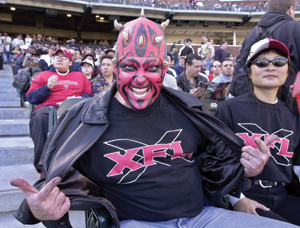 |
AP IMAGES
The football was only part of the fun in cities like San Francisco. |
The standards on the field weren’t nearly as high, even though XFL executives still say it was legitimate football. The league was overjoyed when Las Vegas attached betting lines to XFL games.
“Once we had that, and people realized that the quarterback wasn’t going to get hit over the head with a chair and no one was going to pull the ref’s pants down, I figured we were OK,” Hicks said.
Mike Keller, the XFL’s vice president of football operations who is now a sports marketing consultant in San Diego, considers the XFL’s level of play better than that of other upstart leagues.
“We wanted the best players not playing in the NFL,” Keller said. “It was as good as the USFL was in its first year. We were better than the CFL and the arena league. There wasn’t a college team that could have played with us.”
The perceived quality of XFL was overshadowed by the league’s gimmicks, though, including the game-opening scramble — where two players raced for possession of the ball instead of having a coin toss — along with the player nicknames, most notably He Hate Me (see story).
But while its brand of football won’t be remembered, across sports, the XFL is recognized for several television innovations.
“Look at some of the things we pioneered there: the cable cams, miking all the players, sideline interviews, locker room access, just getting inside the game more than ever — and you realize that now most of that is in practice across sports,” said Jon Miller, president of programming for NBC Sports and Versus. “It was something NFL Films had always done, but it had never been part of a broadcast, so we take a lot of pride in achieving that.”
The XFL was the first football league that brought TV viewers closer to the game and gave viewers a better sense of who the players were, said longtime media consultant Mike Trager, who did not work on the XFL. “Guys were allowed closer proximity to the players,” he said.
Vasgersian said the practice of having each team’s starters announce their positions and where they went to college started with the XFL. The nicknames, like Rod Smart’s He Hate Me, also helped viewers get to know the players — although Vasgersian said one nickname nearly caused problems, when a member of the New York/New Jersey Hitmen tried to get the nickname Teabagger sewed onto the back of his jersey. Just before kickoff, the league made him change.
“I was about two hours away from identifying a tackle made by Teabagger,” Vasgersian said.
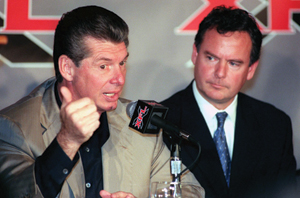 |
NEWSCOM
XFL boss Vince McMahon (left) and league VP Billy Hicks at an August 2000 news conference |
Joann Klonowski, chief marketing officer for the Los Angeles Xtreme, said she remains proud of the league’s productions. “A lot of things we did in our TV production have been adopted by the NFL and across sports,” said Klonowski, whose decades-long career in sports marketing and entertainment also has featured stints with NBA, MLB and MLS clubs, along with events that include the 1994 World Cup and 1999 Women’s World Cup. “We all wear that as kind of a badge of honor.”
Another badge of honor is Klonowski’s championship ring, provided by McMahon to players and front-office personnel even after the league folded. McMahon’s fulfillment of all contracts also made him a hero to many players after the league folded.
But like many others, John Filippelli sees the XFL’s legacy as a mixed bag.
“The NFL has loosened up to allow things like skycams and on-field interviews. All those things were directly because of the push from the XFL,” said Filippelli, a former vice president of production at ABC Sports and, while at NBC Sports, a producer and coordinating producer for the NFL. “Look at ‘Hard Knocks’ [on HBO]. The NFL would have had no part of those 10 years ago. Overall, it’s extremely subjective, which you want to remember about the XFL in hindsight. For creativity, I give it an A. For the actual football product, it was a D.” Filippelli is currently president of production and programming for YES Network.
Prior to the XFL’s launch, everyone from Ebersol down had guaranteed the league was in for a minimum of two seasons, so when the plug was pulled on May 10, 2001, the decision was seen as stunning. The league had been looking at expansion, with Washington, D.C., and Detroit as prime candidates. Rose, the consultant, had just returned from Chicago and Milwaukee, where he’d been scouting new locations for the league’s Chicago Enforcers franchise because its home, Soldier Field, was being closed for renovations.
“No one that I worked with knew that it was going to happen,” said Jack Trompeter, the Enforcers’ vice president of marketing who now is vice president of sponsorships sales for Fox Sports Enterprises/Pac-10 Properties. “The thought that it would be over in a year never crossed my mind.”
Ebersol, however, had been promising advertisers an average rating of between 4 and 5, and the XFL averaged only a 3.0. Only the first two games generated a rating above 4.
“Our [NBC] target,” Klonowski said, “was 18- to 34-year-old males, but we found out they just don’t stay home and watch football on Saturday nights.”
During the 2001 press conference announcing the league’s cancellation, Ebersol said that NBC lost around $50 million on the XFL. “If we had more time, we certainly could have — probably from an offensive standpoint — had a more consistent product,” he said.
DiNardo, the Birmingham coach, said he was in Stamford, Conn., with other coaches for league meetings when he heard about the league’s demise.
“We were talking about expansion, improving the game, and we [took] a dinner break,” DiNardo said. “I go back to the hotel for dinner, and we got emails for a conference call at 5 p.m. That’s when they said that the league was folding. It was the longest dinner break in history.”
Before the collapse, the XFL champion Los Angeles Xtreme had been trying to figure out what the best place in their offices would be to display their trophy. Then McKay got the call that the league was shuttering.
“One of my first thoughts was, ‘I’m taking this thing home,’” he said. “There’s only going to be one of these. We won it, so I might as well have it — at least until someone starts an XFL Hall of Fame.”
Staff writer John Lombardo contributed to this report.
XFL-ology: Take the XFL quiz.








